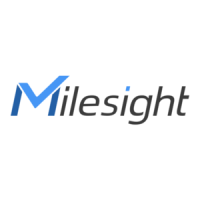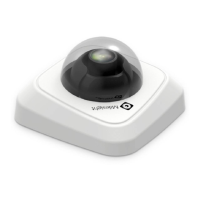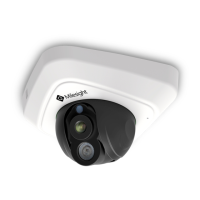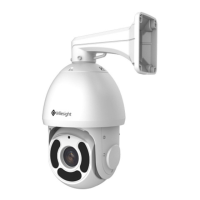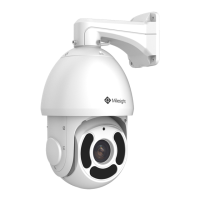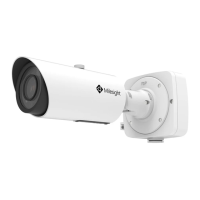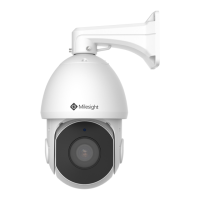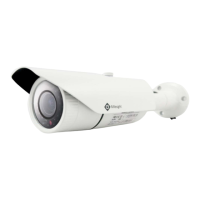Do you have a question about the Milesight MS-C5364-PB and is the answer not in the manual?
Covers warnings and cautions for safe operation, installation, and handling.
Details on electrical safety, avoiding moisture, and handling hot components.
Information on WEEE and battery disposal directives for EU compliance.
An overview of Milesight network cameras, their functionalities, and applications.
Identifies hardware components and notes for various dome and bullet camera models.
Identifies hardware components and notes for the Mini Bullet Network Camera.
Identifies hardware components and notes for the Vandal-proof Mini Bullet camera.
Identifies hardware components and notes for the Motorized Mini Bullet camera.
Identifies hardware components and notes for the 180° Panoramic Mini Bullet camera.
Identifies hardware components and notes for the 180° Panoramic Mini Dome camera.
Identifies hardware components and notes for the Motorized Pro Bullet camera.
Identifies hardware components and notes for the Motorized Pro Dome camera.
Identifies hardware components and notes for the Pro Box Network Camera.
Instructions for connecting the alarm interface and water-proof connector.
Lists the operating system, CPU, RAM, graphic memory, and browser requirements.
Covers direct PC connection and connection via switch or router.
Steps for connecting the camera via a router using dynamic IP.
Explains how to assign an IP address for camera accessibility.
Guides on assigning IP addresses using Milesight Smart Tools software.
Details on assigning IP addresses using a web browser.
Instructions for accessing the camera via Internet Explorer using a plugin.
Explains accessing the camera using Plugin-Free Mode in modern browsers.
Introduces Milesight VMS and guides on installing and adding cameras.
Describes how to view live video streams and use interface controls.
Covers capturing, recording, audio, zoom, and other live view functions.
Instructions to access playback and use controls for viewing recorded videos.
Details on navigating playback, local settings, and basic video settings.
Configuration options for primary, secondary, and tertiary video streams.
Controls for image display, brightness, contrast, and Day/Night modes.
Settings for IR balance, white balance, motion blur, defog, and digital stabilization.
Configuration for BLC, WDR, HLC, and anti-flicker adjustments.
Customizing On Screen Display and setting privacy masks.
Setting up Region of Interest for targeted preview and recording.
Settings for audio input and output features, including denoising and volume.
Instructions for uploading audio files for camera use.
Options for automatic or fixed IP address assignment.
Configuring HTTP/HTTPS access and providing stream URL examples.
Settings for RTSP access and providing stream URL examples.
Enabling UPnP for seamless network connection and port mapping.
Configuring Dynamic Domain Name System for remote access via domain names.
Configuring DDNS provider details and email notification settings.
Settings for email encryption and configuring FTP for alarm file transfer.
Details on 802.1x security, Bonjour device discovery, and RTMP streaming protocol.
Setting the system time zone, daylight saving, and NTP synchronization.
Configuring motion detection sensitivity, region, and schedule.
Setting actions for alarms, such as saving recordings or uploading via FTP/SMTP.
Configuring HTTP notifications and external output actions for alarms.
Enabling and configuring audio alarm threshold, sample value, and schedule.
Configuring external input triggers and managing external output status.
Selecting alarm types and configuring corresponding alarm actions.
Managing storage via SD card and configuring NAS for network storage.
Configuring recording settings, recycle storage, pre-record, and snapshot options.
Managing user accounts, privileges, and security questions for camera access.
Configuring IP access control and enabling SSH for secure remote access.
Setting up watermarks and configuring the SIP protocol for communication.
Configuring SIP registration, user accounts, and alarm phone lists.
Configuring white lists and introducing Video Content Analysis technology.
Configuring region entrance detection to trigger alarms for object entry.
Configuring region exiting and advanced motion detection features.
Configuring tamper detection for camera security.
Configuring line crossing detection and alarm actions.
Configuring loitering detection and alarm settings.
Configuring human detection, tracks, schedules, and alarm actions.
Configuring people counting detection lines, schedules, and logs.
Configuring object left/removed detection and general VCA settings.
Configuring VCA process FPS and minimum/maximum object sizes.
Enabling face detection, setting regions, schedules, and capture configurations.
Enabling message posting for face detection to third-party devices.
Introduction to Heat Map and configuration of sensitivity, object size, and dwell time.
Setting detection regions and schedules for Heat Map analysis.
Generating Space and Time Heat Map reports based on selected criteria.
Configuring automatic export of Heat Map reports to various destinations.
Viewing and filtering logs based on time, IP, and log types.
Searching logs using parameters and exporting log data.
Viewing live LPR results and configuring LPR settings.
Entering LPR license and optimizing night mode recognition.
Setting recognition areas and configuring LPR parameters like resolution and detection modes.
Configuring vehicle speed detection and managing LPR recognition areas.
Configuring detection triggers, confidence levels, and message posting for LPR.
Customizing OSD information on LPR snapshots.
Adding license plates to black/white lists and managing the lists.
Enabling black list mode, setting schedules, and alarm actions.
Enabling white list mode, setting schedules, and alarm actions.
Enabling visitor mode, setting schedules, and alarm actions.
Displaying LPR results and setting search parameters like plate type and time.
Viewing license plate details and exporting search results.
Displays information about the camera's hardware and software.
Performing system maintenance tasks like upgrades and resets.
Steps for performing local and online system upgrades.
Managing configuration files and rebooting the device.
Scheduling automatic reboots for the camera to maintain performance.
Contact details for Milesight technical support and problem submission.
Covers warnings and cautions for safe operation, installation, and handling.
Details on electrical safety, avoiding moisture, and handling hot components.
Information on WEEE and battery disposal directives for EU compliance.
An overview of Milesight network cameras, their functionalities, and applications.
Identifies hardware components and notes for various dome and bullet camera models.
Identifies hardware components and notes for the Mini Bullet Network Camera.
Identifies hardware components and notes for the Vandal-proof Mini Bullet camera.
Identifies hardware components and notes for the Motorized Mini Bullet camera.
Identifies hardware components and notes for the 180° Panoramic Mini Bullet camera.
Identifies hardware components and notes for the 180° Panoramic Mini Dome camera.
Identifies hardware components and notes for the Motorized Pro Bullet camera.
Identifies hardware components and notes for the Motorized Pro Dome camera.
Identifies hardware components and notes for the Pro Box Network Camera.
Instructions for connecting the alarm interface and water-proof connector.
Lists the operating system, CPU, RAM, graphic memory, and browser requirements.
Covers direct PC connection and connection via switch or router.
Steps for connecting the camera via a router using dynamic IP.
Explains how to assign an IP address for camera accessibility.
Guides on assigning IP addresses using Milesight Smart Tools software.
Details on assigning IP addresses using a web browser.
Instructions for accessing the camera via Internet Explorer using a plugin.
Explains accessing the camera using Plugin-Free Mode in modern browsers.
Introduces Milesight VMS and guides on installing and adding cameras.
Describes how to view live video streams and use interface controls.
Covers capturing, recording, audio, zoom, and other live view functions.
Instructions to access playback and use controls for viewing recorded videos.
Details on navigating playback, local settings, and basic video settings.
Configuration options for primary, secondary, and tertiary video streams.
Controls for image display, brightness, contrast, and Day/Night modes.
Settings for IR balance, white balance, motion blur, defog, and digital stabilization.
Configuration for BLC, WDR, HLC, and anti-flicker adjustments.
Customizing On Screen Display and setting privacy masks.
Setting up Region of Interest for targeted preview and recording.
Settings for audio input and output features, including denoising and volume.
Instructions for uploading audio files for camera use.
Options for automatic or fixed IP address assignment.
Configuring HTTP/HTTPS access and providing stream URL examples.
Settings for RTSP access and providing stream URL examples.
Enabling UPnP for seamless network connection and port mapping.
Configuring Dynamic Domain Name System for remote access via domain names.
Configuring DDNS provider details and email notification settings.
Settings for email encryption and configuring FTP for alarm file transfer.
Details on 802.1x security, Bonjour device discovery, and RTMP streaming protocol.
Setting the system time zone, daylight saving, and NTP synchronization.
Configuring motion detection sensitivity, region, and schedule.
Setting actions for alarms, such as saving recordings or uploading via FTP/SMTP.
Configuring HTTP notifications and external output actions for alarms.
Enabling and configuring audio alarm threshold, sample value, and schedule.
Configuring external input triggers and managing external output status.
Selecting alarm types and configuring corresponding alarm actions.
Managing storage via SD card and configuring NAS for network storage.
Configuring recording settings, recycle storage, pre-record, and snapshot options.
Managing user accounts, privileges, and security questions for camera access.
Configuring IP access control and enabling SSH for secure remote access.
Setting up watermarks and configuring the SIP protocol for communication.
Configuring SIP registration, user accounts, and alarm phone lists.
Configuring white lists and introducing Video Content Analysis technology.
Configuring region entrance detection to trigger alarms for object entry.
Configuring region exiting and advanced motion detection features.
Configuring tamper detection for camera security.
Configuring line crossing detection and alarm actions.
Configuring loitering detection and alarm settings.
Configuring human detection, tracks, schedules, and alarm actions.
Configuring people counting detection lines, schedules, and logs.
Configuring object left/removed detection and general VCA settings.
Configuring VCA process FPS and minimum/maximum object sizes.
Enabling face detection, setting regions, schedules, and capture configurations.
Enabling message posting for face detection to third-party devices.
Introduction to Heat Map and configuration of sensitivity, object size, and dwell time.
Setting detection regions and schedules for Heat Map analysis.
Generating Space and Time Heat Map reports based on selected criteria.
Configuring automatic export of Heat Map reports to various destinations.
Viewing and filtering logs based on time, IP, and log types.
Searching logs using parameters and exporting log data.
Viewing live LPR results and configuring LPR settings.
Entering LPR license and optimizing night mode recognition.
Setting recognition areas and configuring LPR parameters like resolution and detection modes.
Configuring vehicle speed detection and managing LPR recognition areas.
Configuring detection triggers, confidence levels, and message posting for LPR.
Customizing OSD information on LPR snapshots.
Adding license plates to black/white lists and managing the lists.
Enabling black list mode, setting schedules, and alarm actions.
Enabling white list mode, setting schedules, and alarm actions.
Enabling visitor mode, setting schedules, and alarm actions.
Displaying LPR results and setting search parameters like plate type and time.
Viewing license plate details and exporting search results.
Displays information about the camera's hardware and software.
Performing system maintenance tasks like upgrades and resets.
Steps for performing local and online system upgrades.
Managing configuration files and rebooting the device.
Scheduling automatic reboots for the camera to maintain performance.
Contact details for Milesight technical support and problem submission.
| Model | MS-C5364-PB |
|---|---|
| Image Sensor | 1/2.8" Progressive Scan CMOS |
| IR Range | 30m |
| Protection | IP67 |
| Type | Bullet Camera |
| Lens | 2.8mm |
| Video Compression | H.265/H.264 |
| Operating Temperature | -30°C to 60°C |
| Power Supply | PoE (802.3af) |
| Day/Night | IR cut filter |
